HA2032 Corporate and Financial Accounting: ANZ Bank Report 2018
VerifiedAdded on 2023/06/11
|12
|2880
|222
Report
AI Summary
This report evaluates the Australian New Zealand Bank's financial statement disclosures, adhering to Generally Accepted Accounting Principles (GAAP) for consolidated financial statements. It examines the ANZ Bank's annual reports, highlighting their clarity and correctness while suggesting areas for improvement, particularly in pre-acquisition entry analysis. The report assesses the relevance and comparability of the bank's financial information, its environmental reporting practices, and the adequacy of its disclosures. Recommendations are made to enhance future compliance and disclosure effectiveness. Additionally, the report explains the purpose of pre-acquisition entries in consolidated statements, discusses the accounting treatment of shares obtained on a cum-dividend basis, and addresses the handling of pre- and post-acquisition dividends. It also covers the treatment of goodwill and the fair value assessment of subsidiary assets and liabilities upon acquisition.
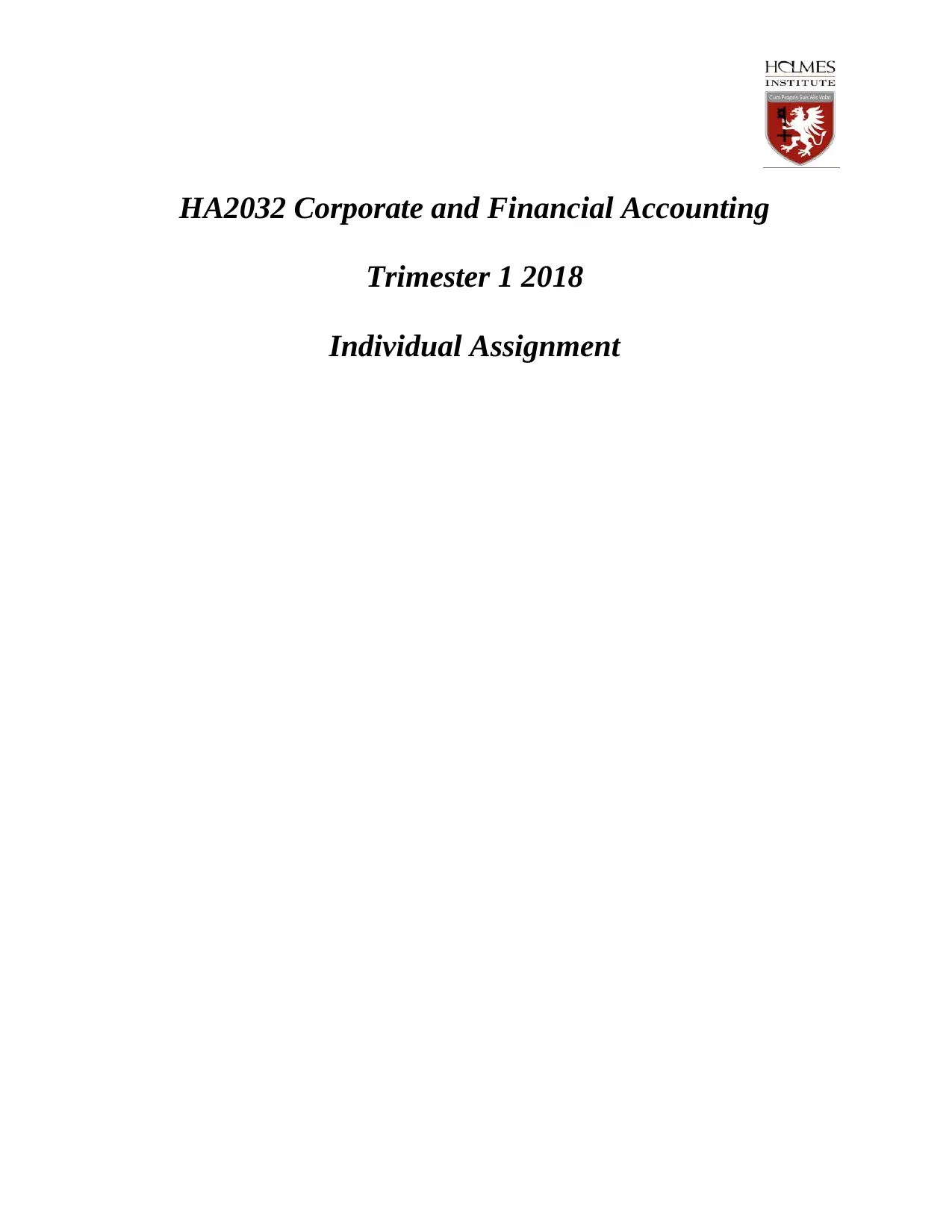
HA2032 Corporate and Financial Accounting
Trimester 1 2018
Individual Assignment
Trimester 1 2018
Individual Assignment
Paraphrase This Document
Need a fresh take? Get an instant paraphrase of this document with our AI Paraphraser
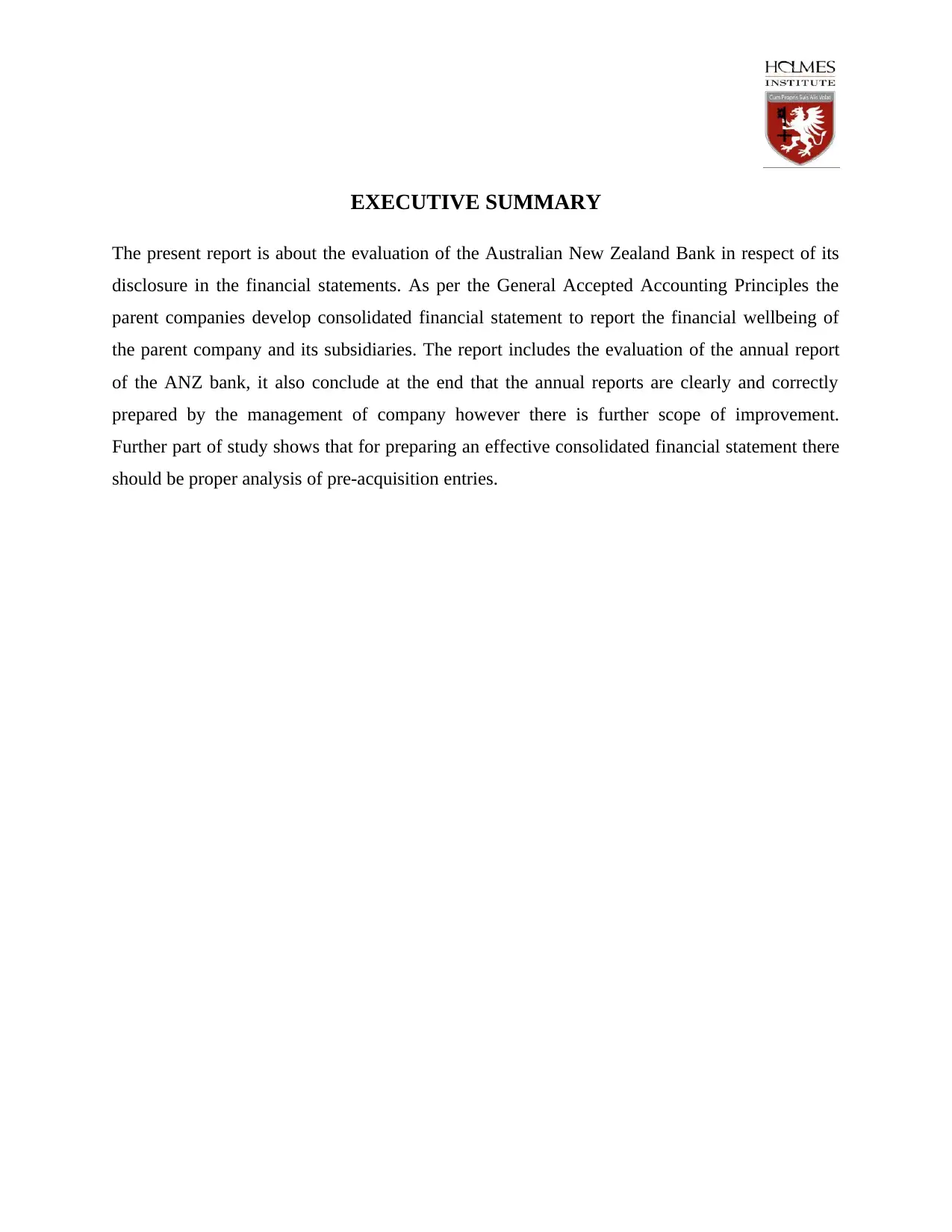
EXECUTIVE SUMMARY
The present report is about the evaluation of the Australian New Zealand Bank in respect of its
disclosure in the financial statements. As per the General Accepted Accounting Principles the
parent companies develop consolidated financial statement to report the financial wellbeing of
the parent company and its subsidiaries. The report includes the evaluation of the annual report
of the ANZ bank, it also conclude at the end that the annual reports are clearly and correctly
prepared by the management of company however there is further scope of improvement.
Further part of study shows that for preparing an effective consolidated financial statement there
should be proper analysis of pre-acquisition entries.
The present report is about the evaluation of the Australian New Zealand Bank in respect of its
disclosure in the financial statements. As per the General Accepted Accounting Principles the
parent companies develop consolidated financial statement to report the financial wellbeing of
the parent company and its subsidiaries. The report includes the evaluation of the annual report
of the ANZ bank, it also conclude at the end that the annual reports are clearly and correctly
prepared by the management of company however there is further scope of improvement.
Further part of study shows that for preparing an effective consolidated financial statement there
should be proper analysis of pre-acquisition entries.
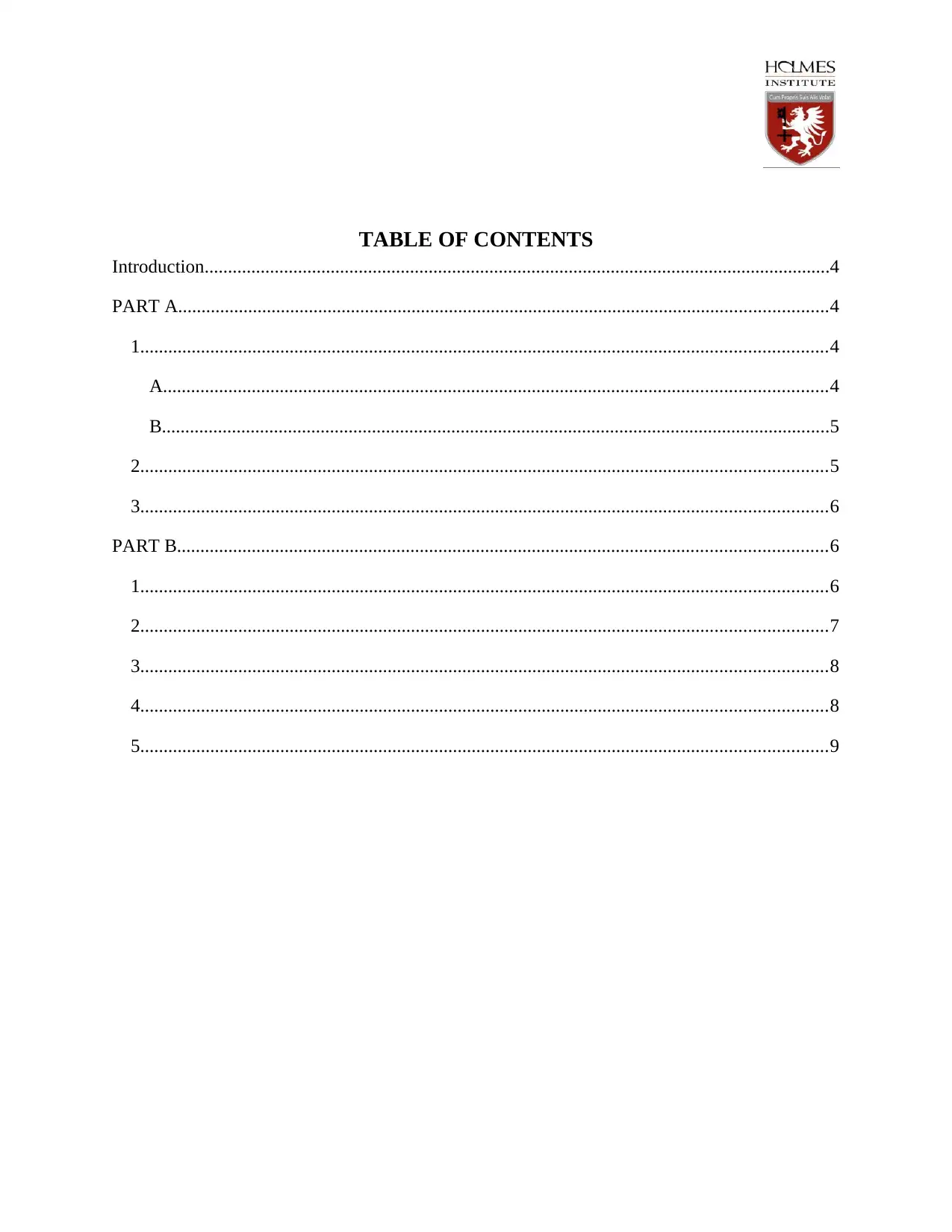
TABLE OF CONTENTS
Introduction......................................................................................................................................4
PART A...........................................................................................................................................4
1...................................................................................................................................................4
A..............................................................................................................................................4
B...............................................................................................................................................5
2...................................................................................................................................................5
3...................................................................................................................................................6
PART B...........................................................................................................................................6
1...................................................................................................................................................6
2...................................................................................................................................................7
3...................................................................................................................................................8
4...................................................................................................................................................8
5...................................................................................................................................................9
Introduction......................................................................................................................................4
PART A...........................................................................................................................................4
1...................................................................................................................................................4
A..............................................................................................................................................4
B...............................................................................................................................................5
2...................................................................................................................................................5
3...................................................................................................................................................6
PART B...........................................................................................................................................6
1...................................................................................................................................................6
2...................................................................................................................................................7
3...................................................................................................................................................8
4...................................................................................................................................................8
5...................................................................................................................................................9
⊘ This is a preview!⊘
Do you want full access?
Subscribe today to unlock all pages.

Trusted by 1+ million students worldwide
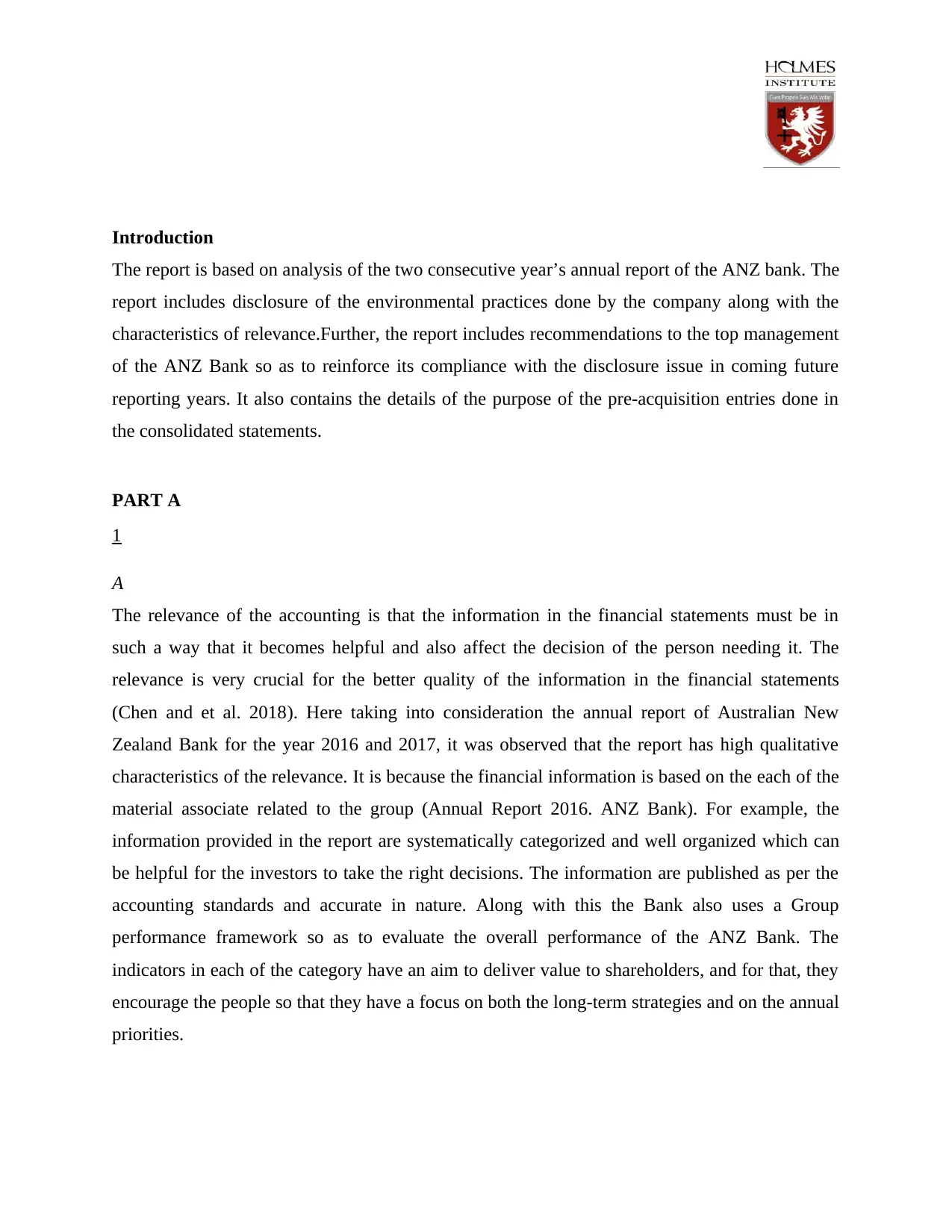
Introduction
The report is based on analysis of the two consecutive year’s annual report of the ANZ bank. The
report includes disclosure of the environmental practices done by the company along with the
characteristics of relevance.Further, the report includes recommendations to the top management
of the ANZ Bank so as to reinforce its compliance with the disclosure issue in coming future
reporting years. It also contains the details of the purpose of the pre-acquisition entries done in
the consolidated statements.
PART A
1
A
The relevance of the accounting is that the information in the financial statements must be in
such a way that it becomes helpful and also affect the decision of the person needing it. The
relevance is very crucial for the better quality of the information in the financial statements
(Chen and et al. 2018). Here taking into consideration the annual report of Australian New
Zealand Bank for the year 2016 and 2017, it was observed that the report has high qualitative
characteristics of the relevance. It is because the financial information is based on the each of the
material associate related to the group (Annual Report 2016. ANZ Bank). For example, the
information provided in the report are systematically categorized and well organized which can
be helpful for the investors to take the right decisions. The information are published as per the
accounting standards and accurate in nature. Along with this the Bank also uses a Group
performance framework so as to evaluate the overall performance of the ANZ Bank. The
indicators in each of the category have an aim to deliver value to shareholders, and for that, they
encourage the people so that they have a focus on both the long-term strategies and on the annual
priorities.
The report is based on analysis of the two consecutive year’s annual report of the ANZ bank. The
report includes disclosure of the environmental practices done by the company along with the
characteristics of relevance.Further, the report includes recommendations to the top management
of the ANZ Bank so as to reinforce its compliance with the disclosure issue in coming future
reporting years. It also contains the details of the purpose of the pre-acquisition entries done in
the consolidated statements.
PART A
1
A
The relevance of the accounting is that the information in the financial statements must be in
such a way that it becomes helpful and also affect the decision of the person needing it. The
relevance is very crucial for the better quality of the information in the financial statements
(Chen and et al. 2018). Here taking into consideration the annual report of Australian New
Zealand Bank for the year 2016 and 2017, it was observed that the report has high qualitative
characteristics of the relevance. It is because the financial information is based on the each of the
material associate related to the group (Annual Report 2016. ANZ Bank). For example, the
information provided in the report are systematically categorized and well organized which can
be helpful for the investors to take the right decisions. The information are published as per the
accounting standards and accurate in nature. Along with this the Bank also uses a Group
performance framework so as to evaluate the overall performance of the ANZ Bank. The
indicators in each of the category have an aim to deliver value to shareholders, and for that, they
encourage the people so that they have a focus on both the long-term strategies and on the annual
priorities.
Paraphrase This Document
Need a fresh take? Get an instant paraphrase of this document with our AI Paraphraser
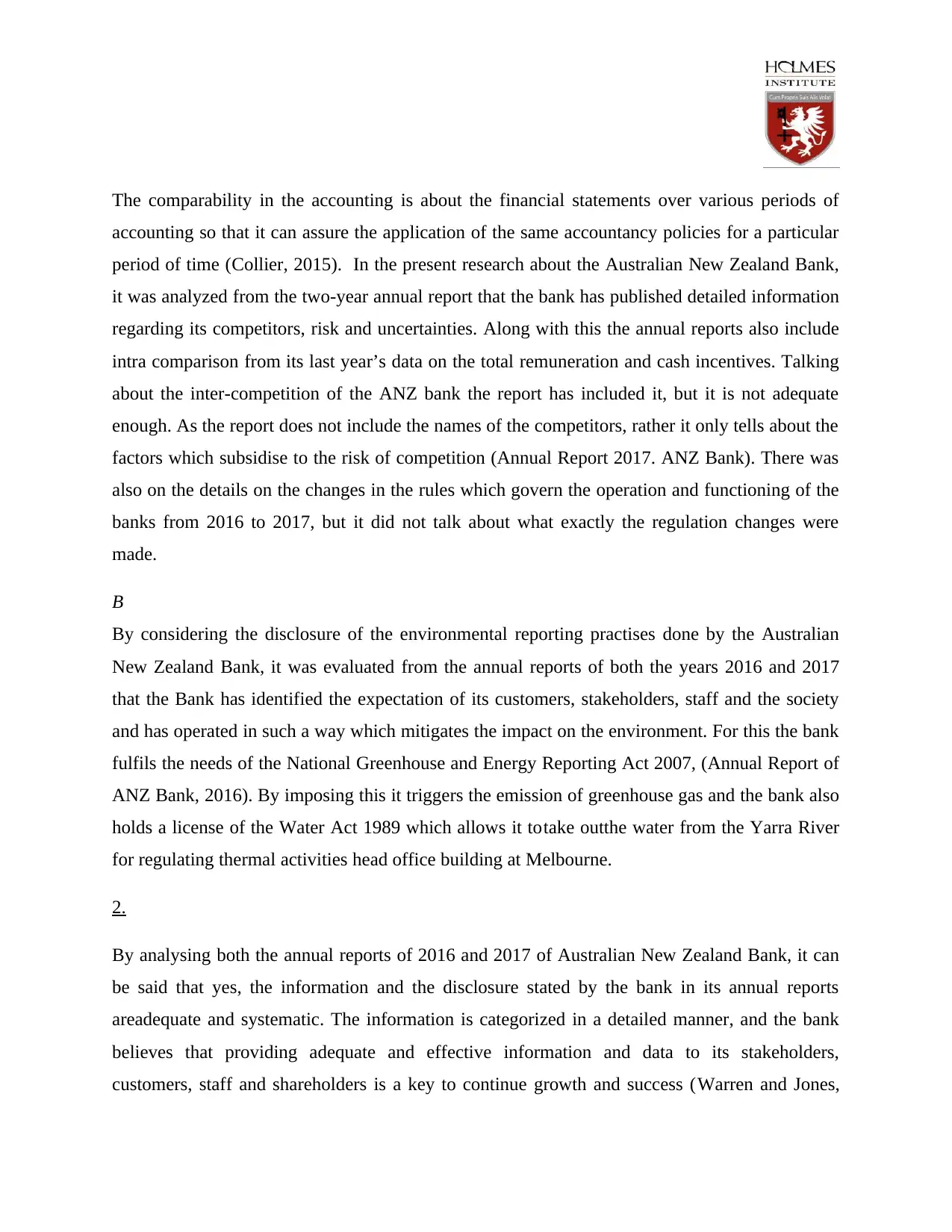
The comparability in the accounting is about the financial statements over various periods of
accounting so that it can assure the application of the same accountancy policies for a particular
period of time (Collier, 2015). In the present research about the Australian New Zealand Bank,
it was analyzed from the two-year annual report that the bank has published detailed information
regarding its competitors, risk and uncertainties. Along with this the annual reports also include
intra comparison from its last year’s data on the total remuneration and cash incentives. Talking
about the inter-competition of the ANZ bank the report has included it, but it is not adequate
enough. As the report does not include the names of the competitors, rather it only tells about the
factors which subsidise to the risk of competition (Annual Report 2017. ANZ Bank). There was
also on the details on the changes in the rules which govern the operation and functioning of the
banks from 2016 to 2017, but it did not talk about what exactly the regulation changes were
made.
B
By considering the disclosure of the environmental reporting practises done by the Australian
New Zealand Bank, it was evaluated from the annual reports of both the years 2016 and 2017
that the Bank has identified the expectation of its customers, stakeholders, staff and the society
and has operated in such a way which mitigates the impact on the environment. For this the bank
fulfils the needs of the National Greenhouse and Energy Reporting Act 2007, (Annual Report of
ANZ Bank, 2016). By imposing this it triggers the emission of greenhouse gas and the bank also
holds a license of the Water Act 1989 which allows it totake outthe water from the Yarra River
for regulating thermal activities head office building at Melbourne.
2.
By analysing both the annual reports of 2016 and 2017 of Australian New Zealand Bank, it can
be said that yes, the information and the disclosure stated by the bank in its annual reports
areadequate and systematic. The information is categorized in a detailed manner, and the bank
believes that providing adequate and effective information and data to its stakeholders,
customers, staff and shareholders is a key to continue growth and success (Warren and Jones,
accounting so that it can assure the application of the same accountancy policies for a particular
period of time (Collier, 2015). In the present research about the Australian New Zealand Bank,
it was analyzed from the two-year annual report that the bank has published detailed information
regarding its competitors, risk and uncertainties. Along with this the annual reports also include
intra comparison from its last year’s data on the total remuneration and cash incentives. Talking
about the inter-competition of the ANZ bank the report has included it, but it is not adequate
enough. As the report does not include the names of the competitors, rather it only tells about the
factors which subsidise to the risk of competition (Annual Report 2017. ANZ Bank). There was
also on the details on the changes in the rules which govern the operation and functioning of the
banks from 2016 to 2017, but it did not talk about what exactly the regulation changes were
made.
B
By considering the disclosure of the environmental reporting practises done by the Australian
New Zealand Bank, it was evaluated from the annual reports of both the years 2016 and 2017
that the Bank has identified the expectation of its customers, stakeholders, staff and the society
and has operated in such a way which mitigates the impact on the environment. For this the bank
fulfils the needs of the National Greenhouse and Energy Reporting Act 2007, (Annual Report of
ANZ Bank, 2016). By imposing this it triggers the emission of greenhouse gas and the bank also
holds a license of the Water Act 1989 which allows it totake outthe water from the Yarra River
for regulating thermal activities head office building at Melbourne.
2.
By analysing both the annual reports of 2016 and 2017 of Australian New Zealand Bank, it can
be said that yes, the information and the disclosure stated by the bank in its annual reports
areadequate and systematic. The information is categorized in a detailed manner, and the bank
believes that providing adequate and effective information and data to its stakeholders,
customers, staff and shareholders is a key to continue growth and success (Warren and Jones,
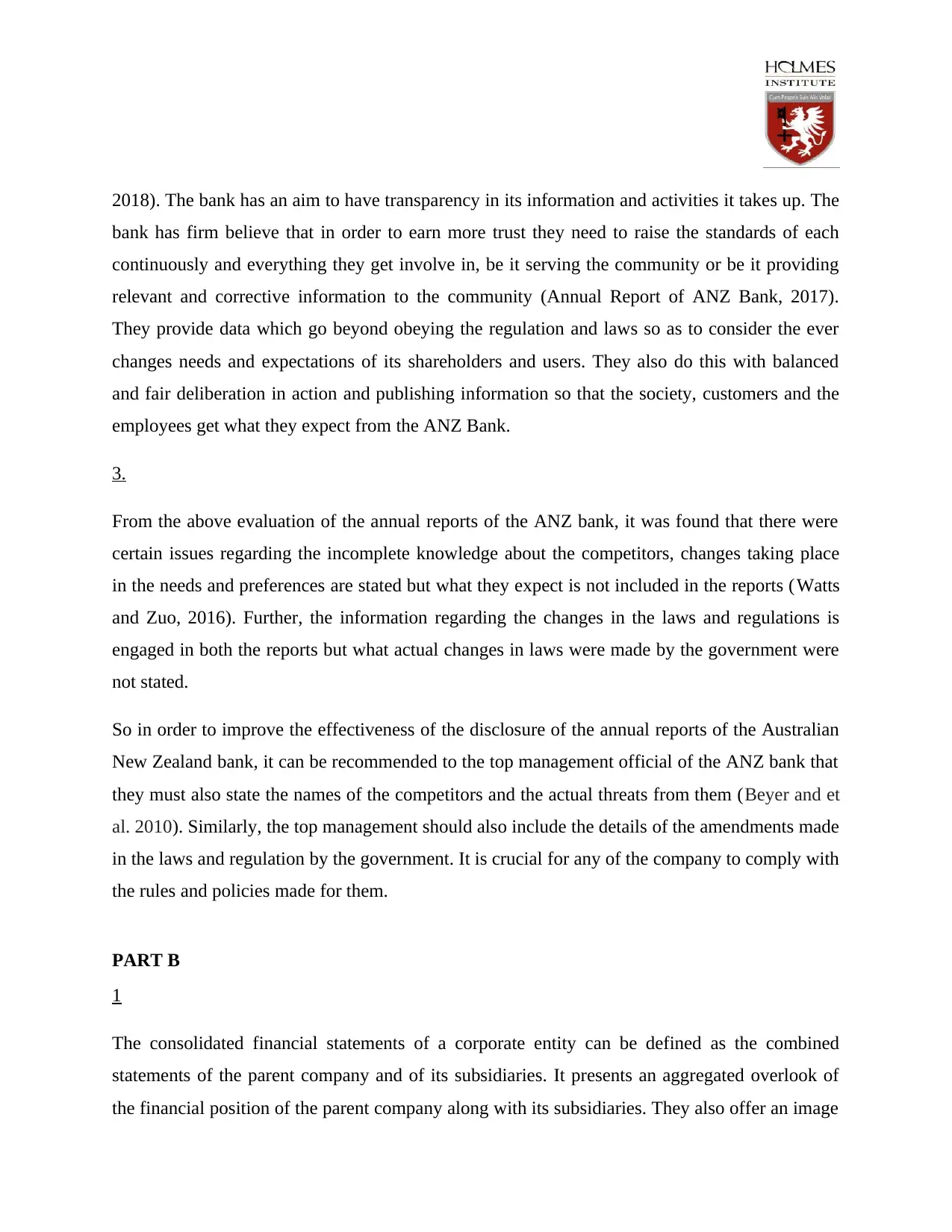
2018). The bank has an aim to have transparency in its information and activities it takes up. The
bank has firm believe that in order to earn more trust they need to raise the standards of each
continuously and everything they get involve in, be it serving the community or be it providing
relevant and corrective information to the community (Annual Report of ANZ Bank, 2017).
They provide data which go beyond obeying the regulation and laws so as to consider the ever
changes needs and expectations of its shareholders and users. They also do this with balanced
and fair deliberation in action and publishing information so that the society, customers and the
employees get what they expect from the ANZ Bank.
3.
From the above evaluation of the annual reports of the ANZ bank, it was found that there were
certain issues regarding the incomplete knowledge about the competitors, changes taking place
in the needs and preferences are stated but what they expect is not included in the reports (Watts
and Zuo, 2016). Further, the information regarding the changes in the laws and regulations is
engaged in both the reports but what actual changes in laws were made by the government were
not stated.
So in order to improve the effectiveness of the disclosure of the annual reports of the Australian
New Zealand bank, it can be recommended to the top management official of the ANZ bank that
they must also state the names of the competitors and the actual threats from them (Beyer and et
al. 2010). Similarly, the top management should also include the details of the amendments made
in the laws and regulation by the government. It is crucial for any of the company to comply with
the rules and policies made for them.
PART B
1
The consolidated financial statements of a corporate entity can be defined as the combined
statements of the parent company and of its subsidiaries. It presents an aggregated overlook of
the financial position of the parent company along with its subsidiaries. They also offer an image
bank has firm believe that in order to earn more trust they need to raise the standards of each
continuously and everything they get involve in, be it serving the community or be it providing
relevant and corrective information to the community (Annual Report of ANZ Bank, 2017).
They provide data which go beyond obeying the regulation and laws so as to consider the ever
changes needs and expectations of its shareholders and users. They also do this with balanced
and fair deliberation in action and publishing information so that the society, customers and the
employees get what they expect from the ANZ Bank.
3.
From the above evaluation of the annual reports of the ANZ bank, it was found that there were
certain issues regarding the incomplete knowledge about the competitors, changes taking place
in the needs and preferences are stated but what they expect is not included in the reports (Watts
and Zuo, 2016). Further, the information regarding the changes in the laws and regulations is
engaged in both the reports but what actual changes in laws were made by the government were
not stated.
So in order to improve the effectiveness of the disclosure of the annual reports of the Australian
New Zealand bank, it can be recommended to the top management official of the ANZ bank that
they must also state the names of the competitors and the actual threats from them (Beyer and et
al. 2010). Similarly, the top management should also include the details of the amendments made
in the laws and regulation by the government. It is crucial for any of the company to comply with
the rules and policies made for them.
PART B
1
The consolidated financial statements of a corporate entity can be defined as the combined
statements of the parent company and of its subsidiaries. It presents an aggregated overlook of
the financial position of the parent company along with its subsidiaries. They also offer an image
⊘ This is a preview!⊘
Do you want full access?
Subscribe today to unlock all pages.

Trusted by 1+ million students worldwide
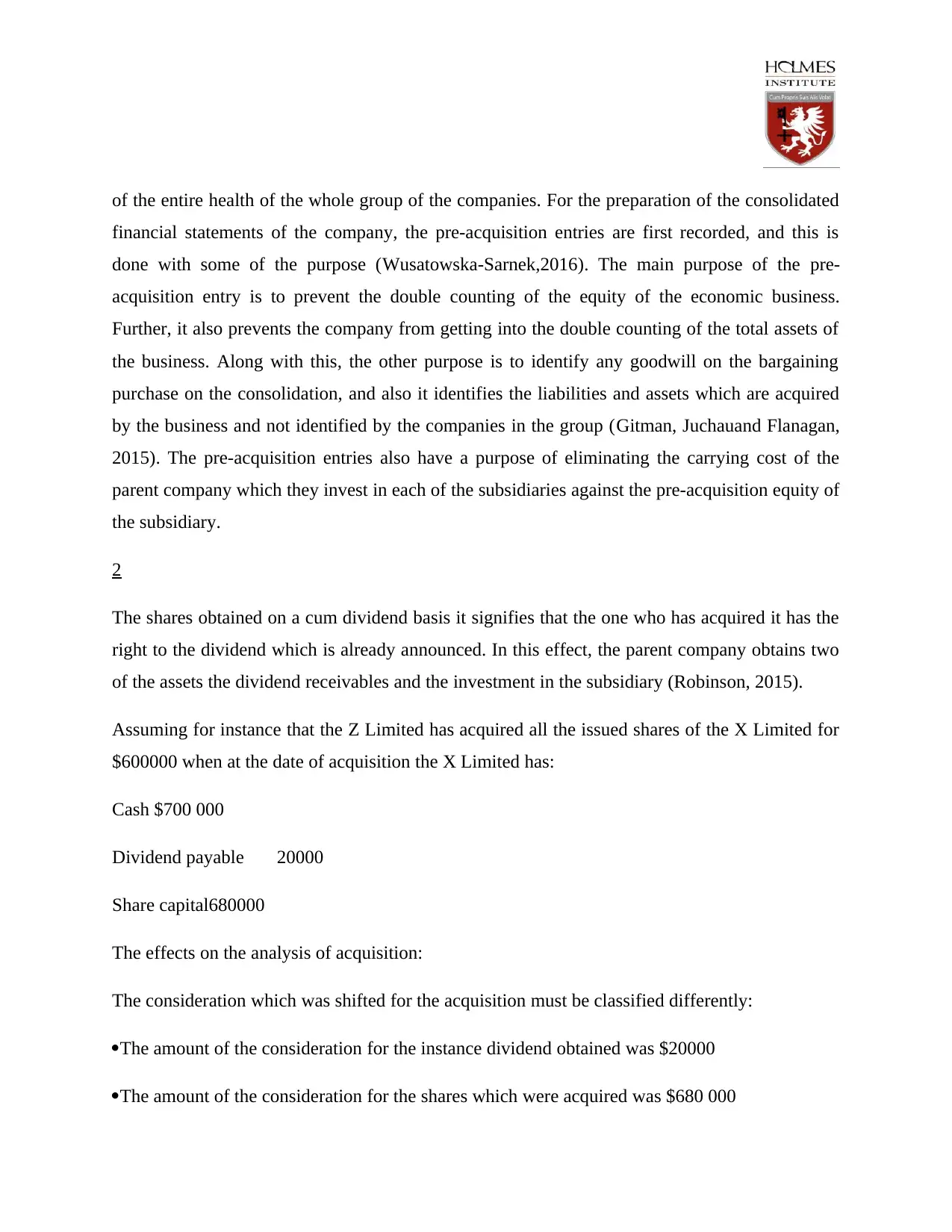
of the entire health of the whole group of the companies. For the preparation of the consolidated
financial statements of the company, the pre-acquisition entries are first recorded, and this is
done with some of the purpose (Wusatowska-Sarnek,2016). The main purpose of the pre-
acquisition entry is to prevent the double counting of the equity of the economic business.
Further, it also prevents the company from getting into the double counting of the total assets of
the business. Along with this, the other purpose is to identify any goodwill on the bargaining
purchase on the consolidation, and also it identifies the liabilities and assets which are acquired
by the business and not identified by the companies in the group (Gitman, Juchauand Flanagan,
2015). The pre-acquisition entries also have a purpose of eliminating the carrying cost of the
parent company which they invest in each of the subsidiaries against the pre-acquisition equity of
the subsidiary.
2
The shares obtained on a cum dividend basis it signifies that the one who has acquired it has the
right to the dividend which is already announced. In this effect, the parent company obtains two
of the assets the dividend receivables and the investment in the subsidiary (Robinson, 2015).
Assuming for instance that the Z Limited has acquired all the issued shares of the X Limited for
$600000 when at the date of acquisition the X Limited has:
Cash $700 000
Dividend payable 20000
Share capital680000
The effects on the analysis of acquisition:
The consideration which was shifted for the acquisition must be classified differently:
The amount of the consideration for the instance dividend obtained was $20000
The amount of the consideration for the shares which were acquired was $680 000
financial statements of the company, the pre-acquisition entries are first recorded, and this is
done with some of the purpose (Wusatowska-Sarnek,2016). The main purpose of the pre-
acquisition entry is to prevent the double counting of the equity of the economic business.
Further, it also prevents the company from getting into the double counting of the total assets of
the business. Along with this, the other purpose is to identify any goodwill on the bargaining
purchase on the consolidation, and also it identifies the liabilities and assets which are acquired
by the business and not identified by the companies in the group (Gitman, Juchauand Flanagan,
2015). The pre-acquisition entries also have a purpose of eliminating the carrying cost of the
parent company which they invest in each of the subsidiaries against the pre-acquisition equity of
the subsidiary.
2
The shares obtained on a cum dividend basis it signifies that the one who has acquired it has the
right to the dividend which is already announced. In this effect, the parent company obtains two
of the assets the dividend receivables and the investment in the subsidiary (Robinson, 2015).
Assuming for instance that the Z Limited has acquired all the issued shares of the X Limited for
$600000 when at the date of acquisition the X Limited has:
Cash $700 000
Dividend payable 20000
Share capital680000
The effects on the analysis of acquisition:
The consideration which was shifted for the acquisition must be classified differently:
The amount of the consideration for the instance dividend obtained was $20000
The amount of the consideration for the shares which were acquired was $680 000
Paraphrase This Document
Need a fresh take? Get an instant paraphrase of this document with our AI Paraphraser
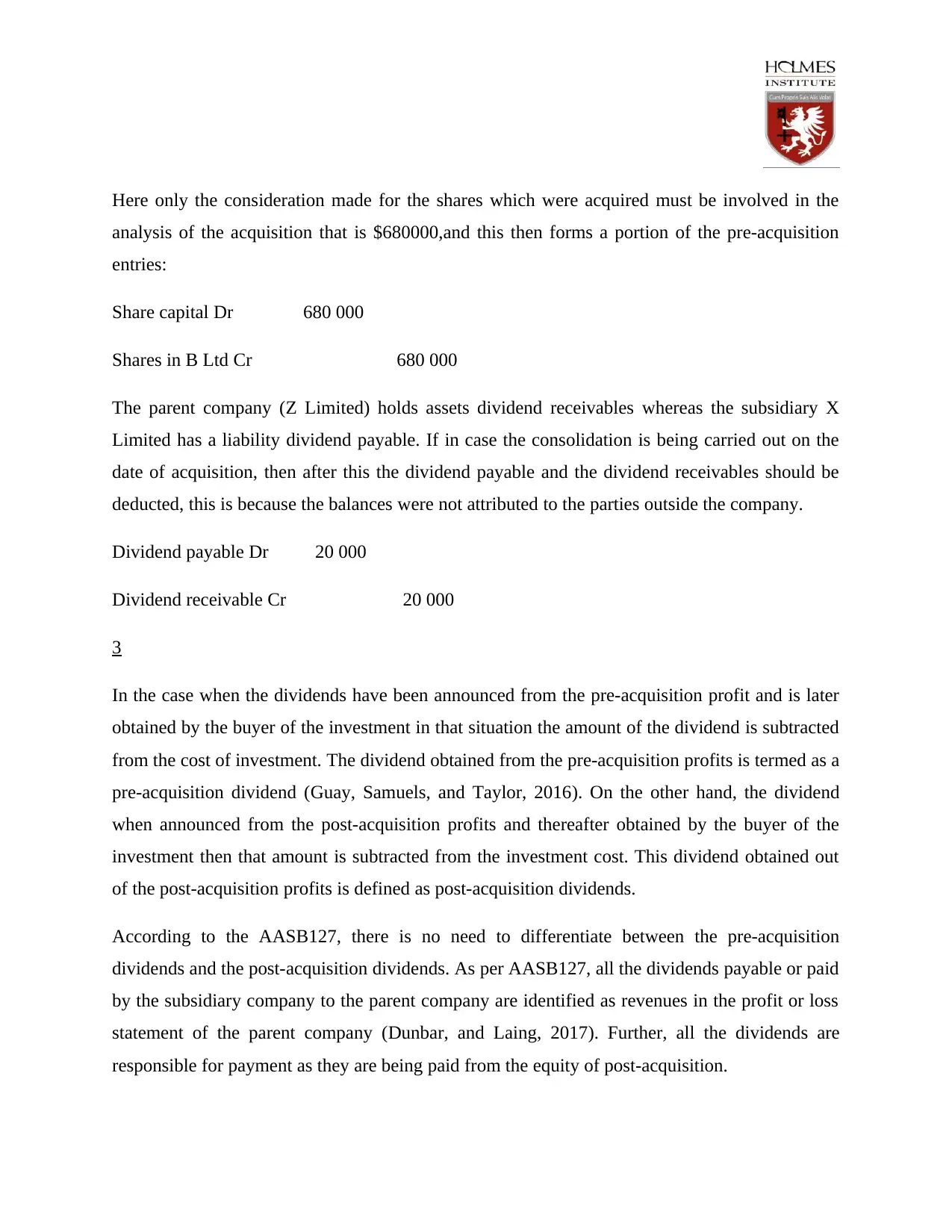
Here only the consideration made for the shares which were acquired must be involved in the
analysis of the acquisition that is $680000,and this then forms a portion of the pre-acquisition
entries:
Share capital Dr 680 000
Shares in B Ltd Cr 680 000
The parent company (Z Limited) holds assets dividend receivables whereas the subsidiary X
Limited has a liability dividend payable. If in case the consolidation is being carried out on the
date of acquisition, then after this the dividend payable and the dividend receivables should be
deducted, this is because the balances were not attributed to the parties outside the company.
Dividend payable Dr 20 000
Dividend receivable Cr 20 000
3
In the case when the dividends have been announced from the pre-acquisition profit and is later
obtained by the buyer of the investment in that situation the amount of the dividend is subtracted
from the cost of investment. The dividend obtained from the pre-acquisition profits is termed as a
pre-acquisition dividend (Guay, Samuels, and Taylor, 2016). On the other hand, the dividend
when announced from the post-acquisition profits and thereafter obtained by the buyer of the
investment then that amount is subtracted from the investment cost. This dividend obtained out
of the post-acquisition profits is defined as post-acquisition dividends.
According to the AASB127, there is no need to differentiate between the pre-acquisition
dividends and the post-acquisition dividends. As per AASB127, all the dividends payable or paid
by the subsidiary company to the parent company are identified as revenues in the profit or loss
statement of the parent company (Dunbar, and Laing, 2017). Further, all the dividends are
responsible for payment as they are being paid from the equity of post-acquisition.
analysis of the acquisition that is $680000,and this then forms a portion of the pre-acquisition
entries:
Share capital Dr 680 000
Shares in B Ltd Cr 680 000
The parent company (Z Limited) holds assets dividend receivables whereas the subsidiary X
Limited has a liability dividend payable. If in case the consolidation is being carried out on the
date of acquisition, then after this the dividend payable and the dividend receivables should be
deducted, this is because the balances were not attributed to the parties outside the company.
Dividend payable Dr 20 000
Dividend receivable Cr 20 000
3
In the case when the dividends have been announced from the pre-acquisition profit and is later
obtained by the buyer of the investment in that situation the amount of the dividend is subtracted
from the cost of investment. The dividend obtained from the pre-acquisition profits is termed as a
pre-acquisition dividend (Guay, Samuels, and Taylor, 2016). On the other hand, the dividend
when announced from the post-acquisition profits and thereafter obtained by the buyer of the
investment then that amount is subtracted from the investment cost. This dividend obtained out
of the post-acquisition profits is defined as post-acquisition dividends.
According to the AASB127, there is no need to differentiate between the pre-acquisition
dividends and the post-acquisition dividends. As per AASB127, all the dividends payable or paid
by the subsidiary company to the parent company are identified as revenues in the profit or loss
statement of the parent company (Dunbar, and Laing, 2017). Further, all the dividends are
responsible for payment as they are being paid from the equity of post-acquisition.
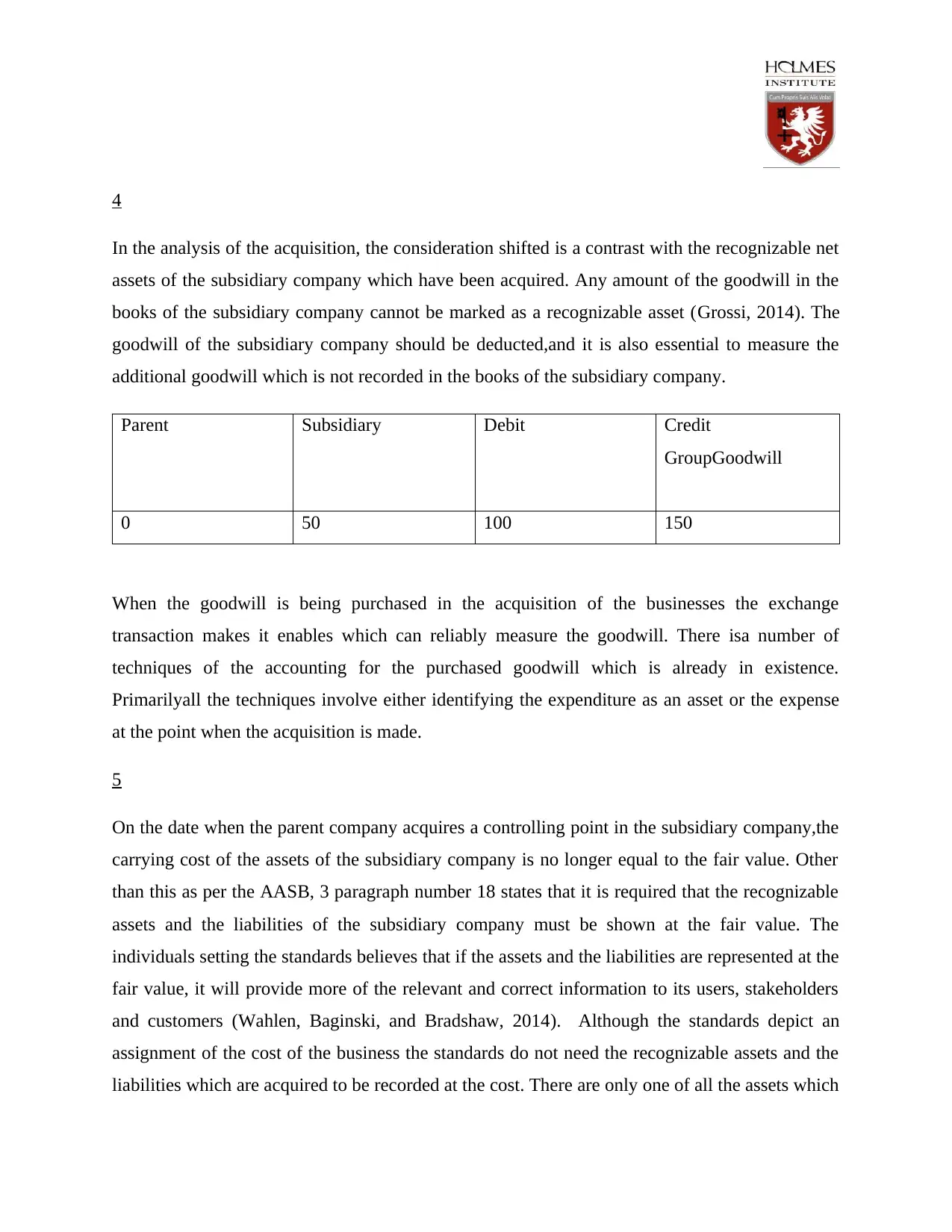
4
In the analysis of the acquisition, the consideration shifted is a contrast with the recognizable net
assets of the subsidiary company which have been acquired. Any amount of the goodwill in the
books of the subsidiary company cannot be marked as a recognizable asset (Grossi, 2014). The
goodwill of the subsidiary company should be deducted,and it is also essential to measure the
additional goodwill which is not recorded in the books of the subsidiary company.
Parent Subsidiary Debit Credit
GroupGoodwill
0 50 100 150
When the goodwill is being purchased in the acquisition of the businesses the exchange
transaction makes it enables which can reliably measure the goodwill. There isa number of
techniques of the accounting for the purchased goodwill which is already in existence.
Primarilyall the techniques involve either identifying the expenditure as an asset or the expense
at the point when the acquisition is made.
5
On the date when the parent company acquires a controlling point in the subsidiary company,the
carrying cost of the assets of the subsidiary company is no longer equal to the fair value. Other
than this as per the AASB, 3 paragraph number 18 states that it is required that the recognizable
assets and the liabilities of the subsidiary company must be shown at the fair value. The
individuals setting the standards believes that if the assets and the liabilities are represented at the
fair value, it will provide more of the relevant and correct information to its users, stakeholders
and customers (Wahlen, Baginski, and Bradshaw, 2014). Although the standards depict an
assignment of the cost of the business the standards do not need the recognizable assets and the
liabilities which are acquired to be recorded at the cost. There are only one of all the assets which
In the analysis of the acquisition, the consideration shifted is a contrast with the recognizable net
assets of the subsidiary company which have been acquired. Any amount of the goodwill in the
books of the subsidiary company cannot be marked as a recognizable asset (Grossi, 2014). The
goodwill of the subsidiary company should be deducted,and it is also essential to measure the
additional goodwill which is not recorded in the books of the subsidiary company.
Parent Subsidiary Debit Credit
GroupGoodwill
0 50 100 150
When the goodwill is being purchased in the acquisition of the businesses the exchange
transaction makes it enables which can reliably measure the goodwill. There isa number of
techniques of the accounting for the purchased goodwill which is already in existence.
Primarilyall the techniques involve either identifying the expenditure as an asset or the expense
at the point when the acquisition is made.
5
On the date when the parent company acquires a controlling point in the subsidiary company,the
carrying cost of the assets of the subsidiary company is no longer equal to the fair value. Other
than this as per the AASB, 3 paragraph number 18 states that it is required that the recognizable
assets and the liabilities of the subsidiary company must be shown at the fair value. The
individuals setting the standards believes that if the assets and the liabilities are represented at the
fair value, it will provide more of the relevant and correct information to its users, stakeholders
and customers (Wahlen, Baginski, and Bradshaw, 2014). Although the standards depict an
assignment of the cost of the business the standards do not need the recognizable assets and the
liabilities which are acquired to be recorded at the cost. There are only one of all the assets which
⊘ This is a preview!⊘
Do you want full access?
Subscribe today to unlock all pages.

Trusted by 1+ million students worldwide
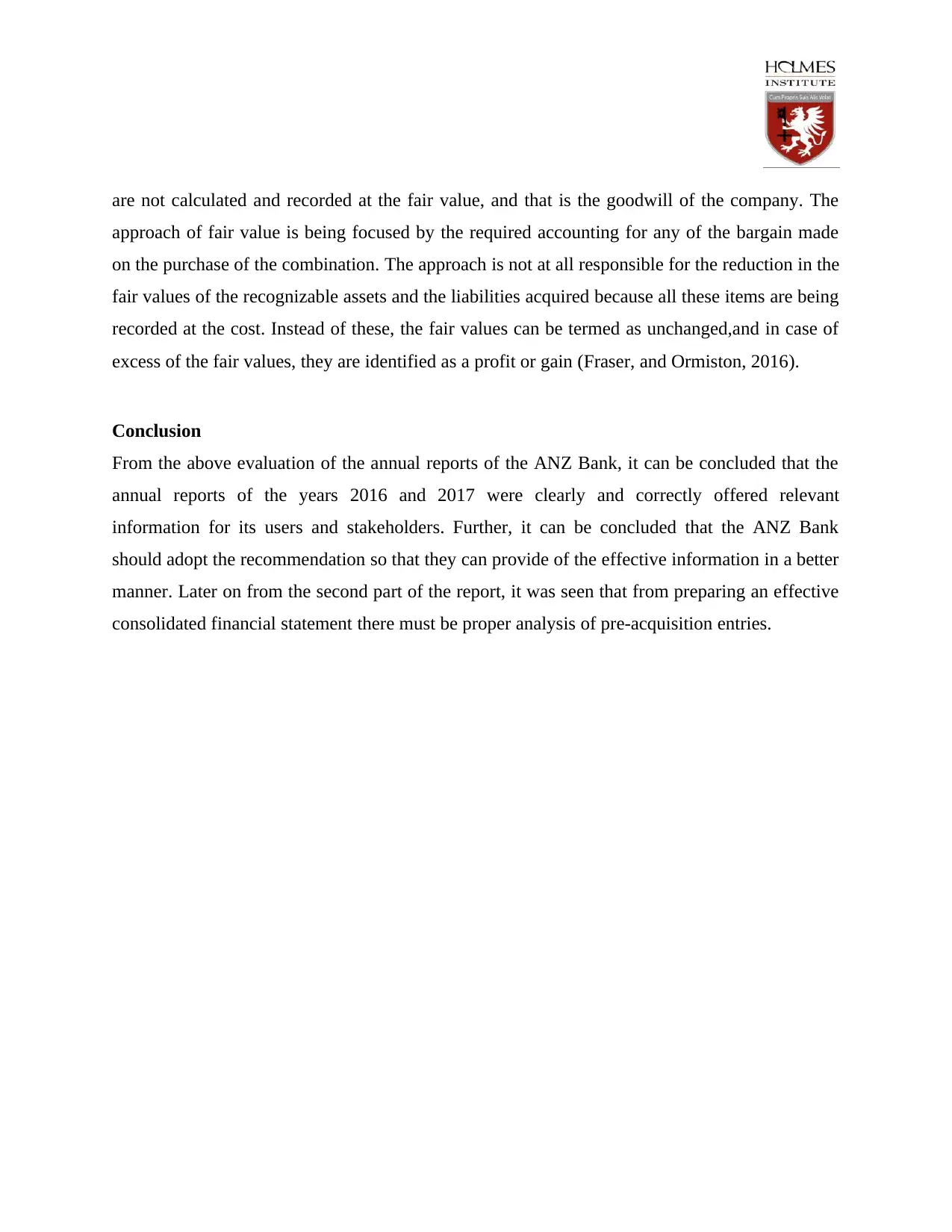
are not calculated and recorded at the fair value, and that is the goodwill of the company. The
approach of fair value is being focused by the required accounting for any of the bargain made
on the purchase of the combination. The approach is not at all responsible for the reduction in the
fair values of the recognizable assets and the liabilities acquired because all these items are being
recorded at the cost. Instead of these, the fair values can be termed as unchanged,and in case of
excess of the fair values, they are identified as a profit or gain (Fraser, and Ormiston, 2016).
Conclusion
From the above evaluation of the annual reports of the ANZ Bank, it can be concluded that the
annual reports of the years 2016 and 2017 were clearly and correctly offered relevant
information for its users and stakeholders. Further, it can be concluded that the ANZ Bank
should adopt the recommendation so that they can provide of the effective information in a better
manner. Later on from the second part of the report, it was seen that from preparing an effective
consolidated financial statement there must be proper analysis of pre-acquisition entries.
approach of fair value is being focused by the required accounting for any of the bargain made
on the purchase of the combination. The approach is not at all responsible for the reduction in the
fair values of the recognizable assets and the liabilities acquired because all these items are being
recorded at the cost. Instead of these, the fair values can be termed as unchanged,and in case of
excess of the fair values, they are identified as a profit or gain (Fraser, and Ormiston, 2016).
Conclusion
From the above evaluation of the annual reports of the ANZ Bank, it can be concluded that the
annual reports of the years 2016 and 2017 were clearly and correctly offered relevant
information for its users and stakeholders. Further, it can be concluded that the ANZ Bank
should adopt the recommendation so that they can provide of the effective information in a better
manner. Later on from the second part of the report, it was seen that from preparing an effective
consolidated financial statement there must be proper analysis of pre-acquisition entries.
Paraphrase This Document
Need a fresh take? Get an instant paraphrase of this document with our AI Paraphraser
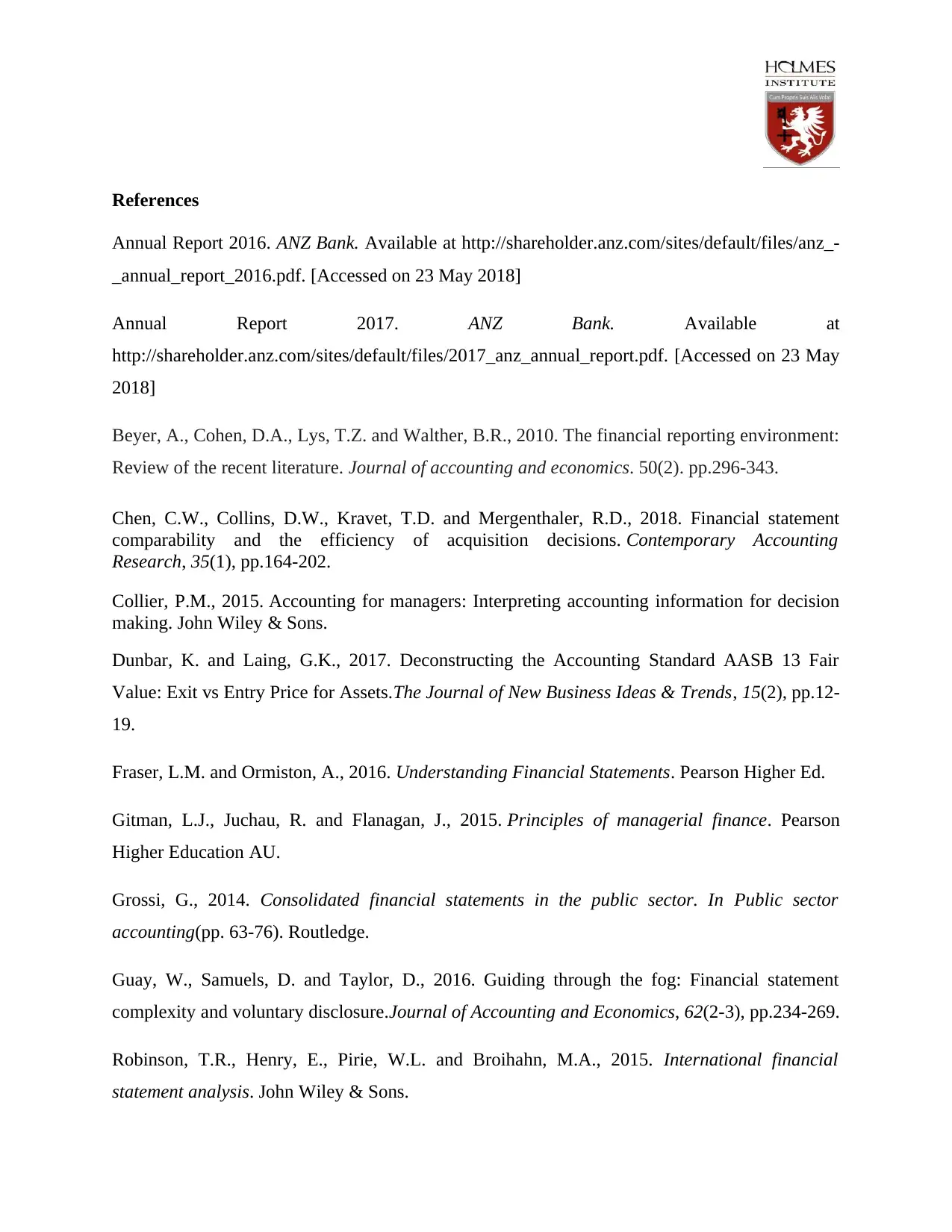
References
Annual Report 2016. ANZ Bank. Available at http://shareholder.anz.com/sites/default/files/anz_-
_annual_report_2016.pdf. [Accessed on 23 May 2018]
Annual Report 2017. ANZ Bank. Available at
http://shareholder.anz.com/sites/default/files/2017_anz_annual_report.pdf. [Accessed on 23 May
2018]
Beyer, A., Cohen, D.A., Lys, T.Z. and Walther, B.R., 2010. The financial reporting environment:
Review of the recent literature. Journal of accounting and economics. 50(2). pp.296-343.
Chen, C.W., Collins, D.W., Kravet, T.D. and Mergenthaler, R.D., 2018. Financial statement
comparability and the efficiency of acquisition decisions. Contemporary Accounting
Research, 35(1), pp.164-202.
Collier, P.M., 2015. Accounting for managers: Interpreting accounting information for decision
making. John Wiley & Sons.
Dunbar, K. and Laing, G.K., 2017. Deconstructing the Accounting Standard AASB 13 Fair
Value: Exit vs Entry Price for Assets.The Journal of New Business Ideas & Trends, 15(2), pp.12-
19.
Fraser, L.M. and Ormiston, A., 2016. Understanding Financial Statements. Pearson Higher Ed.
Gitman, L.J., Juchau, R. and Flanagan, J., 2015. Principles of managerial finance. Pearson
Higher Education AU.
Grossi, G., 2014. Consolidated financial statements in the public sector. In Public sector
accounting(pp. 63-76). Routledge.
Guay, W., Samuels, D. and Taylor, D., 2016. Guiding through the fog: Financial statement
complexity and voluntary disclosure.Journal of Accounting and Economics, 62(2-3), pp.234-269.
Robinson, T.R., Henry, E., Pirie, W.L. and Broihahn, M.A., 2015. International financial
statement analysis. John Wiley & Sons.
Annual Report 2016. ANZ Bank. Available at http://shareholder.anz.com/sites/default/files/anz_-
_annual_report_2016.pdf. [Accessed on 23 May 2018]
Annual Report 2017. ANZ Bank. Available at
http://shareholder.anz.com/sites/default/files/2017_anz_annual_report.pdf. [Accessed on 23 May
2018]
Beyer, A., Cohen, D.A., Lys, T.Z. and Walther, B.R., 2010. The financial reporting environment:
Review of the recent literature. Journal of accounting and economics. 50(2). pp.296-343.
Chen, C.W., Collins, D.W., Kravet, T.D. and Mergenthaler, R.D., 2018. Financial statement
comparability and the efficiency of acquisition decisions. Contemporary Accounting
Research, 35(1), pp.164-202.
Collier, P.M., 2015. Accounting for managers: Interpreting accounting information for decision
making. John Wiley & Sons.
Dunbar, K. and Laing, G.K., 2017. Deconstructing the Accounting Standard AASB 13 Fair
Value: Exit vs Entry Price for Assets.The Journal of New Business Ideas & Trends, 15(2), pp.12-
19.
Fraser, L.M. and Ormiston, A., 2016. Understanding Financial Statements. Pearson Higher Ed.
Gitman, L.J., Juchau, R. and Flanagan, J., 2015. Principles of managerial finance. Pearson
Higher Education AU.
Grossi, G., 2014. Consolidated financial statements in the public sector. In Public sector
accounting(pp. 63-76). Routledge.
Guay, W., Samuels, D. and Taylor, D., 2016. Guiding through the fog: Financial statement
complexity and voluntary disclosure.Journal of Accounting and Economics, 62(2-3), pp.234-269.
Robinson, T.R., Henry, E., Pirie, W.L. and Broihahn, M.A., 2015. International financial
statement analysis. John Wiley & Sons.
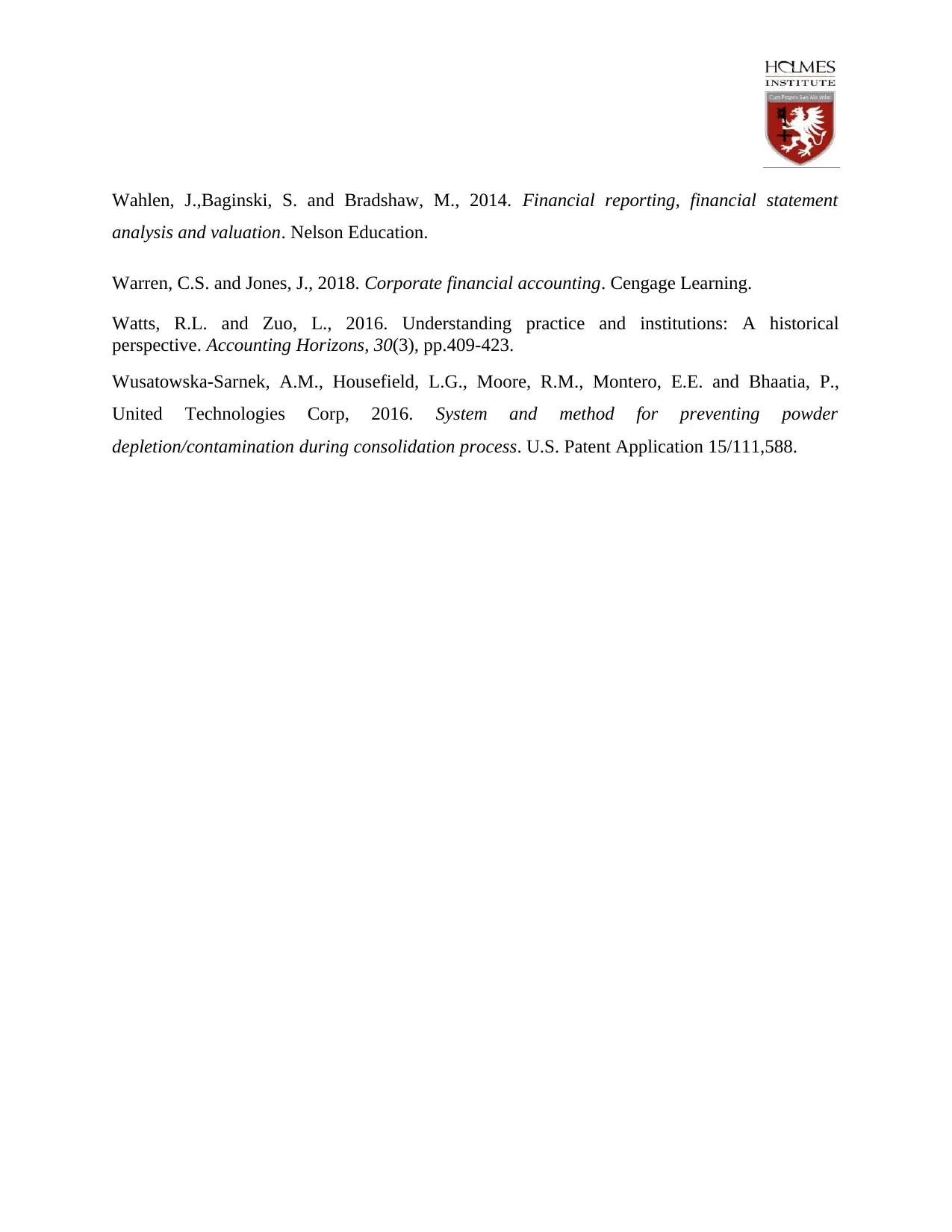
Wahlen, J.,Baginski, S. and Bradshaw, M., 2014. Financial reporting, financial statement
analysis and valuation. Nelson Education.
Warren, C.S. and Jones, J., 2018. Corporate financial accounting. Cengage Learning.
Watts, R.L. and Zuo, L., 2016. Understanding practice and institutions: A historical
perspective. Accounting Horizons, 30(3), pp.409-423.
Wusatowska-Sarnek, A.M., Housefield, L.G., Moore, R.M., Montero, E.E. and Bhaatia, P.,
United Technologies Corp, 2016. System and method for preventing powder
depletion/contamination during consolidation process. U.S. Patent Application 15/111,588.
analysis and valuation. Nelson Education.
Warren, C.S. and Jones, J., 2018. Corporate financial accounting. Cengage Learning.
Watts, R.L. and Zuo, L., 2016. Understanding practice and institutions: A historical
perspective. Accounting Horizons, 30(3), pp.409-423.
Wusatowska-Sarnek, A.M., Housefield, L.G., Moore, R.M., Montero, E.E. and Bhaatia, P.,
United Technologies Corp, 2016. System and method for preventing powder
depletion/contamination during consolidation process. U.S. Patent Application 15/111,588.
⊘ This is a preview!⊘
Do you want full access?
Subscribe today to unlock all pages.

Trusted by 1+ million students worldwide
1 out of 12
Related Documents
Your All-in-One AI-Powered Toolkit for Academic Success.
+13062052269
info@desklib.com
Available 24*7 on WhatsApp / Email
![[object Object]](/_next/static/media/star-bottom.7253800d.svg)
Unlock your academic potential
Copyright © 2020–2025 A2Z Services. All Rights Reserved. Developed and managed by ZUCOL.



